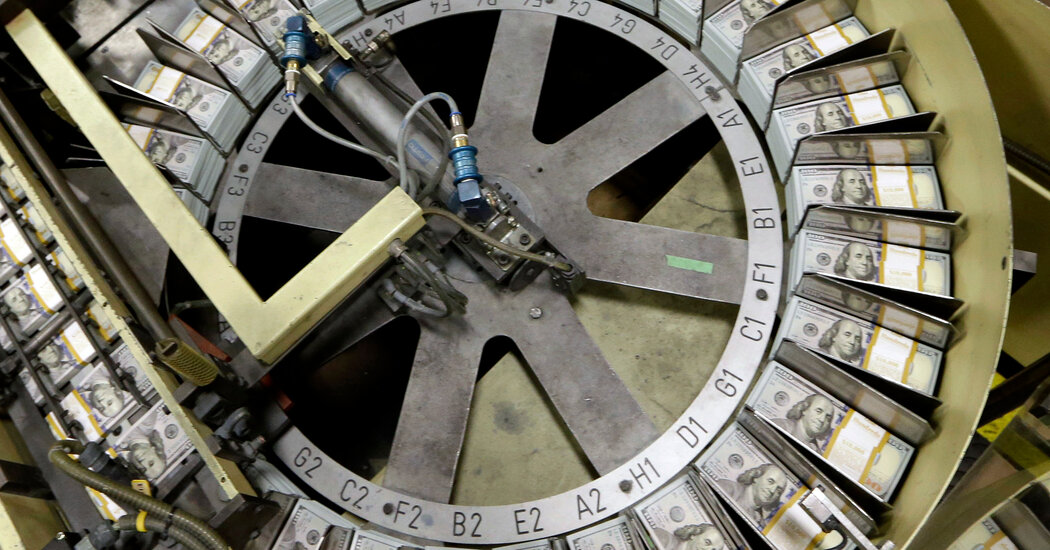A few days ago, Tressie McMillan Cottom published an insightful article in The Times about the power of “folk economics” — which she defined as “the very human impulse to describe complex economic processes in lay terms.” Her subject was the widespread enthusiasm for cryptocurrency, but her article sent me down memory lane, recalling the role folk economics has played in past policy debates.
Just to be clear, the “folk” who hold plausible-sounding but wrongheaded views of the economy needn’t be members of the working class. They can be, and often are, members of the elite: plutocrats, powerful politicians and influential pundits. In fact, elite embrace of folk economics was a large part of what went wrong in the global response to the 2008 financial crisis. And it’s starting to have a destructive effect now.
So, memories: When the 2008 financial crisis struck, economists, believe it or not, had an intellectual framework ready to go, pretty much custom-made for that situation — because it was devised in the 1930s during the Great Depression. The “IS-LM model” was introduced by the British economist John Hicks in 1937 as an attempt to encapsulate the insights of John Maynard Keynes, who had published “The General Theory of Employment, Interest and Money” the previous year. There’s endless argument about whether Hicks was true to Keynes’s vision — which is irrelevant for my discussion now — because Hicks is what economists brought to the table in 2008.
According to IS-LM (which stands for investment-savings, liquidity-money), public policy normally has two tools it can use to fight an economic slump. Loosely speaking, the Fed can print more money to drive interest rates down, or the Treasury can engage in deficit spending to pump up demand. After a financial crisis, however, the economy gets so depressed that monetary policy hits a limit; interest rates can’t go below zero. So, large-scale deficit spending is the appropriate and necessary response.
But folk economics sees deficits as irresponsible and dangerous; if anything, many people have the instinctive feeling that governments should cut back in hard times, not spend more. And this instinct had a big, adverse effect on policy. True, the Obama administration did respond to the slump with fiscal stimulus, but it was underpowered in part because of unwarranted deficit fears. (This isn’t hindsight, and I was tearing my hair out at the time.) And by 2010, influential opinion — the opinion of what I used to call Very Serious People — had shifted around to the view that debt, not mass unemployment, was the most important problem facing the United States and other wealthy nations.
This wasn’t what conventional economics said, and there was no hint that investors were losing faith in U.S. debt. But deficit scaremongering came to dominate political and media discussions, and governments turned to austerity policies that slowed recovery from the Great Recession.
Did economists unanimously oppose austerity? Hey, have economists ever unanimously agreed on anything? (There’s less disagreement within the profession than legend has it, but still.) Indeed, a handful of prominent economists managed to come up with arguments that seemed to support the folk theory that deficits are always bad — an episode that I always think of when I see demands for new economic thinking. You see, during the last crisis the new ideas that actually influenced policy did indeed go against conventional economics — but in ways that supported, rather than challenged, the prejudices of the powerful.
Two papers in particular had a malign influence. One, by Alberto Alesina and Silvia Ardagna, asserted that cutting spending in a depressed economy was actually expansionary, because it would increase confidence. The other, by Carmen Reinhart and Kenneth Rogoff, declared that government debt had big, negative effects on growth when it crossed a critical threshold, around 90 percent of gross domestic product.
Both papers were widely criticized by other economists as soon as they were circulated, and in fairly short order their empirical claims were pretty much demolished by other researchers. But their arguments were eagerly adopted by influential people who liked their message, and a funny thing happened to the discourse in the media: To a large extent, these speculative (and wrong) arguments for austerity were both accepted as fact and presented as the consensus of the economics profession. Back in 2013, I cited a Washington Post editorial that declared “economists” believed that terrible things happen when debt exceeds 90 percent of G.D.P., when in fact this was very much not what the rest of us were saying.
And I’ve been hearing echoes of that misrepresentation in some current debates, as people advocating new economic ideas — or at least what they claim are new ideas — assert that conventional economic thinking was responsible for austerity policies after 2008. Um, no: Fiscal austerity was exactly what conventional economics told us not to do in a depressed economy, and it was only the peddlers of unorthodox economics who gave austerity policies intellectual cover.
Which brings us to our current moment. This time around, fiscal stimulus wasn’t underpowered, and there’s definitely a case to be made that excessive deficit spending in 2021 was a factor in rising inflation (although we can argue about how big a factor, since inflation is also up a lot in countries that didn’t engage in much stimulus). But now what?
As I said, the IS-LM model tells us that policymakers have two tools for managing the overall level of demand: fiscal and monetary policy. When you’re trying to boost a deeply depressed economy, monetary policy becomes unavailable, because you can’t push interest rates below zero. But if you’re trying to cool off an overheated economy, monetary policy is available: Interest rates can’t go down, but they can go up.
And because changing monetary policy is easy, conventional analysis says that monetary tightening is the way to go. Indeed, the Fed has made it clear that it intends to do just that. Getting the pace and size of rate hikes right will be tricky, but conceptually it isn’t hard.
But the folk economics position — where by “folk,” I mainly mean Senator Joe Manchin — is that excessive government spending caused inflation, so now we have to call off any new spending, even if it’s more or less paid for with new revenue.
Well, that’s not what conventional economics says; on the contrary, the standard model says that the Fed can handle this while we deal with other priorities.
And while conventional economics isn’t always right, any people attacking it now should ask themselves whether they’re doing so in a constructive way. In particular, I’m seeing a lot of denigration of monetary policy from people who don’t seem to realize that they are, de facto, giving aid and comfort to politicians who don’t want to invest in America’s children and the fight against climate change.
Quick Hits
The origins of expansionary austerity.
How the media abandoned objectivity over deficits.
Monetary policy matters.
How high can debt go?


























